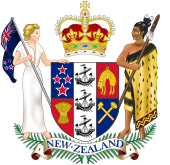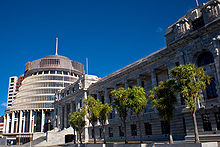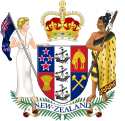- Parliament of New Zealand
-
Parliament of New Zealand
Pāremata Aotearoa49th New Zealand Parliament 
Type Type Unicameral Houses House of Representatives Leadership Speaker of the House of Representatives Lockwood Smith, National Party
since 9 December 2008Leader of the House of Representatives Gerry Brownlee, National Party
since 9 December 2008Members 120 Representatives Meeting place 
Parliament House, Wellington, New Zealand Website www.parliament.nz/en-NZ The Parliament of New Zealand (in Māori: Pāremata Aotearoa) consists of the Queen of New Zealand and the New Zealand House of Representatives and, until 1951, the New Zealand Legislative Council. The House of Representatives is often referred to as "Parliament".
The House of Representatives usually consists of 120 Members of Parliament (MPs), sometimes more due to overhang seats. MPs are directly elected by universal suffrage. The form of New Zealand government essentially follows the Westminster system, and the government is led by the Prime Minister and cabinet who are chosen from amongst the members of the House of Representatives.
Parliament is physically located in Wellington, the capital city of New Zealand since 1865.
Contents
History
The Parliament was established by the British New Zealand Constitution Act 1852 which established a bicameral legislature. This produced a parliament very similar to Britain's, with a lower house, called the General Assembly, and an upper house, called the Legislative Council. The members of the General Assembly were elected under the First Past the Post system, but the members of the Council were appointed. For the most part, the Council rubber-stamped legislation the lower house wished to pass, very rarely playing any notable part in the policy process.
Due to this ineffectiveness, the National government of 1951 abolished the Legislative Council, making New Zealand legislature unicameral. Parliament received full control over all New Zealand affairs in 1947 with the passage of the Statute of Westminster Adoption Act, and the ability to amend its composition with the New Zealand Constitution Amendment Act 1947 (UK). In 1986 a new Constitution Act was passed, restating the 1852 Act's provisions and consolidating the legislation establishing Parliament.
Country Quota
Main article: Country quotaOne historical speciality of the New Zealand Parliament was the country quota, which gave greater representation to rural politics. From 1889 on (and even earlier in more informal forms), districts were weighted according to their urban/rural split (with any locality of less than 2,000 people considered rural). Those districts which had large rural proportions received a greater number of nominal votes than they actually contained voters – as an example, in 1927, Waipawa, a district without any urban population at all, received an additional 4,153 nominal votes to its actual 14,838 – having the maximum factor of 28% extra representation. The country quota was in effect until it was abolished in 1945 by a mostly urban-elected Labour government, which went back to a one voter, one vote system.[1]
Sovereignty
New Zealand 
This article is part of the series:
Politics and government of
New ZealandConstitution Legislative (Parliament)General
The New Zealand Parliament is sovereign with no institution able to over-ride its decisions. The ability of Parliament to act is, legally, unimpeded. For example, the New Zealand Bill of Rights Act is a normal piece of legislation, it is not superior law as written constitutions are in some other countries. The only thing Parliament is limited in its power are on some "entrenched" issues relating to elections. These include the length of its term, deciding on who can vote, how they vote (via secret ballot), how the country should be divided into electorates, and the make up of the Representation Commission which decides on these electorates. These issues require either 75% of all MPs to support the bill or a referendum on the issue. (However, the entrenchment of these provisions is not itself entrenched. Therefore, Parliament can repeal the entrenchment of these issues with a simple majority, then change these issues with a simple majority.)[2]
Houses
New Zealand House of Representatives
Main article: New Zealand House of RepresentativesThe New Zealand House of Representatives has been the New Zealand Parliament's sole chamber since 1951. It is democratically elected every three years, with eighteen select committees to scrutinise legislation.
Upper house
The New Zealand Parliament does not have an upper house; it is unicameral rather than bicameral. There was an upper house up to 1950, and there have been occasional suggestions to create a new one.
Legislative Council
Main article: New Zealand Legislative CouncilThe Legislative Council was intended to scrutinise and amend bills passed by the House of Representatives, although it could not initiate legislation or amend money bills. Despite occasional proposals for an elected Council, Members of the Legislative Council (MLCs) were appointed by the Governor, generally on the recommendation of the Prime Minister. At first, MLCs were appointed for life, but a term of seven years was introduced in 1891. It was eventually decided that the Council was having no significant impact on New Zealand's legislative process, and the terms of its members expired on 31 December 1950. At the time of its abolition it had fifty-four members, including its own Speaker.
Senate proposals
In September 1950, the National government of Sidney Holland set up a constitutional reform committee to consider an alternative second chamber, chaired by Ronald Algie. A report produced by the committee in 1952 proposed a nominated Senate, with 32 members, appointed by leaders of the parties in the House of Representatives, in according to their strength in that House, Senators would serve for three year-terms, and be eligible for reappointment.[3] The Senate would have the power to revise, initiate or delay legislation, to hear petitions, and to scrutinise regulations and Orders in Council but this was rejected by the Prime Minister, and the Labour opposition, which had refused to nominate members to the committee.[4]
The National government of Jim Bolger proposed the establishment of an elected Senate when it came to power in 1990, thereby reinstating a bicameral system, and a Senate Bill was drafted. Under the Bill, the Senate would have 30 members, elected by STV, from six senatorial districts. Like the old Legislative Council, it would not have powers to amend or delay money bills.[5] The House of Representatives would continue to be elected by FPP.
The intention was to include a question on a Senate in the second referendum on electoral reform. Voters would be asked, if they did not want a new voting system, whether or not they wanted a Senate.[6] However, following objections from the Labour opposition, which derided it as a red herring,[7] and other supporters of MMP,[8] the Senate question was removed by the Select Committee on Electoral Reform.
In 2010, the New Zealand Policy Unit of the Centre for Independent Studies proposed a Senate in the context of the 2011 referendum on MMP. They proposed a proportionally-elected upper house made up 31 seats elected using a proportional list vote by region, with the House of Representatives elected by FPP and consisting of 79 seats.[9]
Passage of legislation
The New Zealand Parliament's model for passing Acts of Parliament is similar (but not identical) to that of other Westminster System governments.
Laws are initially proposed in Parliament as bills. They become Acts after being approved three times by Parliamentary votes and then receiving Royal Assent from the Governor-General. The majority of bills are promulgated by the government of the day (that is, the party or parties that have a majority in Parliament). It is rare for government bills to be defeated, indeed the first to be defeated in the twentieth century was in 1998. It is also possible for individual MPs to promote their own bills, called member's bills; these are usually put forward by opposition parties, or by MPs who wish to deal with a matter that parties do not take positions on.
House of Representatives
Further information: New Zealand House of Representatives#Passage of legislationWithin the House of Representatives, bills must pass through three readings and be considered by both a Select Committee and the Committee of the Whole House.
Royal Assent
Further information: Royal Assent#New ZealandIf a Bill passes its third reading, it is passed by the Clerk of the House of Representatives to the Governor-General, who will (assuming constitutional conventions are followed) grant Royal Assent as a matter of course. Some constitutional lawyers, such as Professor Philip Joseph, believe the Governor-General does retain the power to refuse Royal Assent to Bills in exceptional circumstances – specifically if democracy were to be abolished.[10] Others, such as former law professor and Prime Minister Sir Geoffrey Palmer and Matthew Palmer argue any refusal of Royal Assent would lead to a constitutional crisis.[11]
Refusal of Royal Assent has never occurred under any circumstances in New Zealand. Once Royal Assent has been granted, the Bill then becomes law.
Terms of Parliament
Parliament is currently in its 49th term.
See also
- New Zealand Parliament Buildings
- Constitution of New Zealand
- Independence of New Zealand
References
- ^ McKinnon, Malcolm (ed.) (1997). New Zealand Historical Atlas. David Bateman. p. Plate 90.
- ^ Electoral Act 1993 s268
- ^ The New Zealand Legislative Council : A Study of the Establishment, Failure and Abolition of an Upper House, William Keith Jackson, University of Otago Press, page 200
- ^ Memoirs: 1912–1960, Sir John Marshall, Collins, 1984, 159–60
- ^ SENATE BILL : Report of Electoral Law Committee
- ^ New Zealand Legislates for the 1993 Referendum on its Electoral System
- ^ New Zealand Hansard: Tuesday, December 15, 1992 ELECTORAL REFORM BILL : Introduction
- ^ Submission: Electoral Reform Bill (February 1993)
- ^ Luke Malpass and Oliver Marc Hartwich (24 March 2010). "Superseding MMP: Real Electoral Reform for New Zealand". Centre for Independent Studies. http://www.cis.org.nz/policy_monographs/pm109.pdf.
- ^ Philip Joseph (2002). Constitutional and Administrative Law in New Zealand (2nd edition ed.). Brookers. ISBN 9780864723994.
- ^ Sir Geoffrey Palmer and Matthew Palmer (2004). Bridled Power: New Zealand's Constitution and Government (4th edition ed.). Oxford University Press. ISBN 0195584635.
External links
- Parliament of New Zealand
- Images from around Parliament Buildings
- Parliament Today
- Parliament at Radio New Zealand
 New Zealand topics
New Zealand topicsHistory 
Geography Time zones · Environment · National Parks · Marine reserves · Islands · Lakes · Rivers · Caves · Cities · Towns · BiodiversityGovernance Government · Constitution · Parliament · Prime Minister · Law · Cabinet · Supreme Court · Foreign relationsPolitics Economy Society Culture Māori culture · Māori language · NZ English · Art · Cinema · Kiwi (people) · Literature · Music · Sport · Public holidaysMain cities  Book ·
Book ·  Category ·
Category ·  Portal ·
Portal ·  WikiProject
WikiProjectParliaments of Oceania Sovereign states Dependencies and
other territories- American Samoa
- Christmas Island
- Cocos (Keeling) Islands
- Cook Islands
- Easter Island
- French Polynesia
- Guam
- Hawaii
- New Caledonia
- Niue
- Norfolk Island
- Northern Mariana Islands
- Pitcairn Islands
- Tokelau
- Wallis and Futuna
Categories:- Parliament of New Zealand
- Constitution of New Zealand
- Parliaments by country
- Unicameral legislatures
- Defunct bicameral legislatures
Wikimedia Foundation. 2010.



